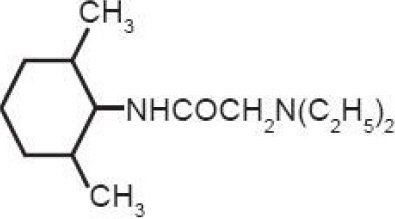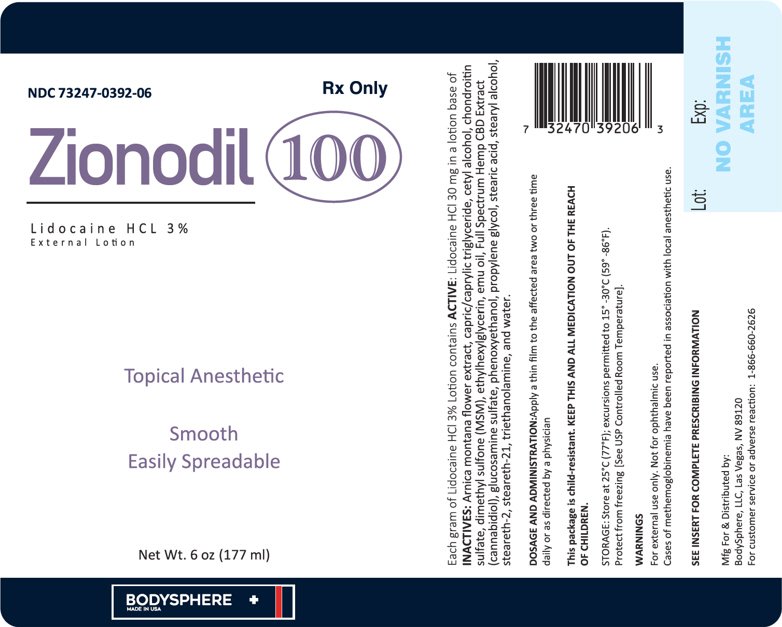Zionodil Lotion: Package Insert / Prescribing Info
Package insert / product label
Generic name: lidocaine hydrochloride
Dosage form: lotion
Drug class: Topical anesthetics
Medically reviewed by Drugs.com. Last updated on Jan 6, 2025.
On This Page
Zionodil Lotion Description
Contains lidocaine HCl 3%. Lidocaine is chemically designated as acetamide, 2-(diethylamino)-N-(2,6-dimethylphenyl), and has the following structure:

C 14H22N2O Mol.wt.234 .34
Each gram of Lidocaine HCl 3% Lotion contains ACTIVE: Lidocaine HCl 30 mg in a lotion base of INACTIVES: Arnica montana flower extract, capric/caprylic triglyceride, cetyl alcohol, chondroitin sulfate, dimethyl sulfone (MSM), ethylhexylglycerin, emu oil, Full Spectrum Hemp CBD Extract (cannabidiol), glucosamine sulfate, phenoxyethanol, propylene glycol, stearic acid, stearyl alcohol, steareth-2, steareth-21, triethanolamine, and water.
Zionodil Lotion - Clinical Pharmacology
MECHANISM OF ACTION
Lidocaine HCl 3% Lotion releases lidocaine which stabilizes the neuronal membrane by inhibiting the ionic fluxes required for initiation and conduction of impulses, thereby effecting local anesthetic action.
PHARMACOKINETICS
Lidocaine may be absorbed following topical administration to mucous membranes, its rate and extent of absorption depending upon the specific site of application, duration of exposure, concentration and total dosage. In general, the rate of absorption of local anesthetic agents following topical application occurs most rapidly after intratracheal administration. Lidocaine is also well-absorbed from the gastrointestinal tract, but little intact drug appears in the circulation because of biotransformation in the liver.
Lidocaine is metabolized rapidly by the liver, and metabolites and unchanged drug are excreted by the kidneys. Biotransformation includes oxidative N-dealkylation, ring hydroxylation, cleavage of the amide linkage, and conjugation. N-dealkylation, a major pathway of biotransformation, yields the metabolites monoethylglycinexylidide and glycinexylidide. The pharmacological / toxicological actions of these metabolites are similar to, but less potent than, those of lidocaine. Approximately 90% of lidocaine administered is excreted in the form of various metabolites, and less than 10% is excreted unchanged. The primary metabolite in urine is a conjugate of 4-hydroxy-2,6-dimethylaniline.
The plasma binding of lidocaine is dependent on drug concentration, and the fraction bound decreases with increasing concentration. At concentrations of 1-4 g of free base per mL, 60 to 80 percent of lidocaine is protein bound. Binding is also dependent on the plasma concentration of the alpha-1-acid glycoprotein.
Lidocaine crosses the blood-brain and placental barriers, presumably by passive diffusion.
Studies of lidocaine metabolism following intravenous bolus injections have shown that the elimination half-life of this agent is typically 1.5 to 2 hours. Because of the rapid rate at which lidocaine is metabolized, any condition that affects liver function may alter lidocaine kinetics. The half-life may be prolonged two-fold or more in patients with liver dysfunction. Renal dysfunction does not affect lidocaine kinetics but may increase the accumulation of metabolites.
Factors such as acidosis and the use of CNS stimulants and depressants affect the CNS levels of lidocaine required to produce overt systemic effects. Objective adverse manifestations become increasingly apparent with increasing venous plasma levels above 6 g free base per mL. In the rhesus monkey, arterial blood levels of 18-21 g/ml have been shown to be threshold for convulsive activity.
Indications and Usage for Zionodil Lotion
Pruritus, pruritic eczemas, abrasions, minor burns, insect bites, pain, soreness and discomfort due to pruritus ani, pruritus vulvae, hemorrhoids, anal fissures, and similar conditions of the skin and mucous membranes.
Contraindications
Traumatized mucosa, secondary bacterial infection of the area of proposed application and known hypersensitivity to any of the components. Lidocaine is contraindicated in patients with a known history of hypersensitivity to local anesthetics of the amide type.
Warnings
For external use only. Not for ophthalmic use.
If irritation or sensitivity occurs or infection appears, discontinue treatment and institute appropriate therapy. Lidocaine HCl 3% Lotion should be used with caution in ill, elderly, debilitated patients and children who may be more sensitive to the systemic effects of lidocaine.
CARCINOGENESIS, MUTAGENESIS AND IMPAIRMENT OF FERTILITY
Studies of lidocaine in animals to evaluate the carcinogenic and mutagenic potential of the effect on fertility have not been conducted.
METHEMOGLOBINEMIA
Cases of methemoglobinemia have been reported in association with local anesthetic use. Although all patients are at risk for methemoglobinemia, patients with glucose-6-phosphate dehydrogenase deficiency, congenital or idiopathic methemoglobinemia, cardiac or pulmonary compromise, infants under 6 months of age, and concurrent exposure to oxidizing agents or their metabolites are more susceptible to developing clinical manifestations of the condition. If local anesthetics must be used in these patients, close monitoring for symptoms and signs of methemoglobinemia is recommended. Signs and symptoms of methemoglobinemia may occur immediately or may be delayed some hours after exposure and are characterized by a cyanotic skin discoloration and abnormal coloration of the blood. Methemoglobin levels may continue to rise; therefore, immediate treatment is required to avert more serious central nervous system and cardiovascular adverse effects, including seizures, coma, arrhythmias, and death. Discontinue Lidocaine 3% Lotion and any other oxidizing agents. Depending on the severity of the symptoms, patients may respond to supportive care, i.e., oxygen therapy, hydration. More severe symptoms may require treatment with methylene blue, exchange transfusion, or hyperbaric oxygen.
| Class | Examples |
|---|---|
| Nitrates/Nitrites | nitroglycerin, nitroprusside, nitric oxide, nitrous oxide |
| Local anesthetics | benzocaine, lidocaine, bupivacaine, mepivacaine, tetracaine, prilocaine, procaine, articaine, ropivacaine |
| Antineoplastic agents | cyclophosphamide, flutamide, rasburicase, ifosfamide,hydroxvurea |
| Antibiotics | dapsone, sulfonamides, nitrofurantoin, para-aminosalicylic acid |
| Antimalarials | chloroquine, primaquine |
| Anticonvulsants | phenvtoin, sodium valoroate, phenobarbital |
| Other drugs | acetaminophen, metoclopramide, sulfa drugs (i.e., sulfasalazine), quinine |
DRUG INTERACTIONS
Patients that are administered local anesthetics may be at increased risk of developing methemoglobinemia when concurrently exposed to the following oxidizing agents:
USE IN PREGNANCY
Teratogenic Effects
Pregnancy Category B
Reproduction studies have been performed in rats at doses up to 6.6 times the human dose and have revealed no evidence of harm to the fetus caused by lidocaine. There are, however, no adequate and well controlled studies in pregnant women. Animal reproduction studies are not always predictive of human response. General consideration should be given to this fact before administering lidocaine to women of childbearing potential, especially during early pregnancy when maximum organogenesis takes place.
Adverse Reactions/Side Effects
During or immediately after treatment, the skin at the site of treatment may develop erythema or edema or maybe the locus of abnormal sensation.
Related/similar drugs
Zionodil Lotion Dosage and Administration
Apply a thin film to the affected area 1 -3 times daily or as directed by a physician.
How is Zionodil Lotion supplied
Lidocaine HCl 3% Lotion is supplied in the following size:
| SIZE | NDC# |
|---|---|
| 6oz. (177 mL) Bottle | 73247-392-06 |
KEEP THIS AND ALL MEDICATION OUT OF THE REACH OF CHILDREN.
| ZIONODIL 100
lidocaine hydrochloride lotion |
||||||||||||||||||||||||||||||||||||||
|
||||||||||||||||||||||||||||||||||||||
|
||||||||||||||||||||||||||||||||||||||
|
||||||||||||||||||||||||||||||||||||||
|
||||||||||||||||||||||||||||||||||||||
|
||||||||||||||||||||||||||||||||||||||
|
||||||||||||||||||||||||||||||||||||||
| Labeler - Bodyshphere, LLC (117131105) |
More about Zionodil (lidocaine topical)
- Check interactions
- Compare alternatives
- Latest FDA alerts (8)
- Side effects
- Dosage information
- During pregnancy
- Drug class: topical anesthetics
- Breastfeeding
Professional resources
Other brands
Lidocaine Viscous, Lidocan Patch, ZTlido, Xylocaine Jelly, ... +34 more

